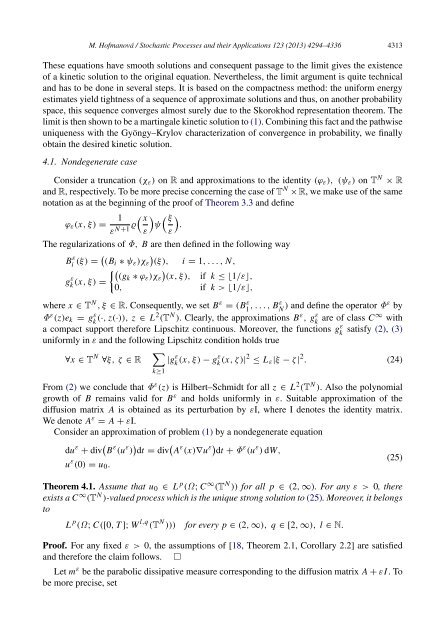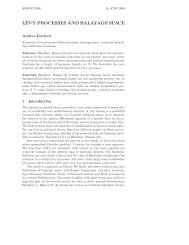Degenerate parabolic stochastic partial differential equations
Degenerate parabolic stochastic partial differential equations
Degenerate parabolic stochastic partial differential equations
Create successful ePaper yourself
Turn your PDF publications into a flip-book with our unique Google optimized e-Paper software.
M. Hofmanová / Stochastic Processes and their Applications 123 (2013) 4294–4336 4313<br />
These <strong>equations</strong> have smooth solutions and consequent passage to the limit gives the existence<br />
of a kinetic solution to the original equation. Nevertheless, the limit argument is quite technical<br />
and has to be done in several steps. It is based on the compactness method: the uniform energy<br />
estimates yield tightness of a sequence of approximate solutions and thus, on another probability<br />
space, this sequence converges almost surely due to the Skorokhod representation theorem. The<br />
limit is then shown to be a martingale kinetic solution to (1). Combining this fact and the pathwise<br />
uniqueness with the Gyöngy–Krylov characterization of convergence in probability, we finally<br />
obtain the desired kinetic solution.<br />
4.1. Nondegenerate case<br />
Consider a truncation (χ ε ) on R and approximations to the identity (ϕ ε ), (ψ ε ) on T N × R<br />
and R, respectively. To be more precise concerning the case of T N ×R, we make use of the same<br />
notation as at the beginning of the proof of Theorem 3.3 and define<br />
ϕ ε (x, ξ) = 1 x<br />
ξ<br />
<br />
ε N+1 ϱ ψ .<br />
ε ε<br />
The regularizations of Φ, B are then defined in the following way<br />
B ε i (ξ) = (B i ∗ ψ ε )χ ε<br />
<br />
(ξ), i = 1, . . . , N,<br />
<br />
gk ε (x, ξ) = (gk ∗ ϕ ε )χ ε (x, ξ), if k ≤ ⌊1/ε⌋,<br />
0, if k > ⌊1/ε⌋,<br />
where x ∈ T N , ξ ∈ R. Consequently, we set B ε = (B1 ε, . . . , Bε N ) and define the operator Φε by<br />
Φ ε (z)e k = gk ε(·, z(·)), z ∈ L2 (T N ). Clearly, the approximations B ε , gk ε are of class C∞ with<br />
a compact support therefore Lipschitz continuous. Moreover, the functions gk ε satisfy (2), (3)<br />
uniformly in ε and the following Lipschitz condition holds true<br />
∀x ∈ T N ∀ξ, ζ ∈ R<br />
|gk ε (x, ξ) − gε k (x, ζ )|2 ≤ L ε |ξ − ζ | 2 . (24)<br />
k≥1<br />
From (2) we conclude that Φ ε (z) is Hilbert–Schmidt for all z ∈ L 2 (T N ). Also the polynomial<br />
growth of B remains valid for B ε and holds uniformly in ε. Suitable approximation of the<br />
diffusion matrix A is obtained as its perturbation by εI, where I denotes the identity matrix.<br />
We denote A ε = A + εI.<br />
Consider an approximation of problem (1) by a nondegenerate equation<br />
du ε + div B ε (u ε ) dt = div A ε (x)∇u ε dt + Φ ε (u ε ) dW,<br />
u ε (0) = u 0 .<br />
(25)<br />
Theorem 4.1. Assume that u 0 ∈ L p (Ω; C ∞ (T N )) for all p ∈ (2, ∞). For any ε > 0, there<br />
exists a C ∞ (T N )-valued process which is the unique strong solution to (25). Moreover, it belongs<br />
to<br />
L p (Ω; C([0, T ]; W l,q (T N ))) for every p ∈ (2, ∞), q ∈ [2, ∞), l ∈ N.<br />
Proof. For any fixed ε > 0, the assumptions of [18, Theorem 2.1, Corollary 2.2] are satisfied<br />
and therefore the claim follows. □<br />
Let m ε be the <strong>parabolic</strong> dissipative measure corresponding to the diffusion matrix A + εI . To<br />
be more precise, set



